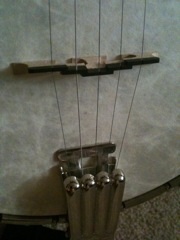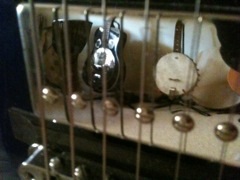Everything changes. The things that we love today are gone so quickly. And by “things†and “love†I mean the pastimes and activities that we use to define ourselves. So much can be communicated about one’s character by simply giving the title of a favorite book or stating a passion for a particular kind of music. These are the loves that fill in the gaps. The thoughts that cement the routine together. Certain songs on the way to work or a book after dinner gives meaning to the mundane. To see the way they have changed and will change can be disconcerting.
I have a library. It isn’t an Umberto Eco library but it’s a pain to move. I love books. I usually can’t leave a book store without dropping $30 to $50. In a good book store like Prairie Lights in Iowa City, Iowa I can walk in and simply let the shelves speak to me. There is always something. I reach out to the shelf and pick it up. It’s there in my hand. I can feel the weight. The physical presence of the object tells me things. I know how many pages are in it and can guess at how long it will take me to read it. I can flip through it and skim a bit. There are margins for doodling and, after I have purchased it, a receipt to fold up and use as a bookmark. But it won’t be like this for long.
When I was in high school in the late eighties and early nineties, things had already changed in the way I listened to music twice. Music went from vinyl records to cassettes and then from cassettes to compact discs. (Note: I’m leaving out the almighty 8-track because, well, we should pretend that some things didn’t happen.) There are some records that by the time I was a senior I had purchased three times! And with each change in medium, something was gained and something was lost.
A record had liner notes. There was a jacket with a huge piece of cover art. The art said nothing about the quality of the music inside, but it was an integral part of the experience. People born after 1980 will just have to take my word for it. Records also enforced time limits. Only so many songs could be on a side. And there were two sides! An A side and a B side. Most of the heavy hitting material was on the top of the album with some often times less heard material on the back. So many great songs were relegated to the B side. I was going to say that the entire B side of Synchronicity by The Police was excellent stuff but I think that that particular album reaches into the future. I’ll get back to that momentarily. The medium dictated form and forced artists to make decisions about their material. A record was a piece of art because of what it was physically.
But records could be scratched and broken. They could melt. And they couldn’t be played in cars. Enter the cassette. There was still some cover art, but it was all but lost. It’s impossible to appreciate a Yes album cover shrunk to that size. It may as well not be there. There was still an A and a B side so the album format was maintained. It was the first step to making music portable and giving us choices. We could listen to a particular tape in the car or on a portable stereo anywhere. We gained something important and lost something important. But it was nothing compared to the next step.
My first CD player was a Sony portable unit with detachable speakers. It had dual cassette decks for making mix tapes and it was awesome. By the time CDs had come into vogue, my record collecting days were over. I had piles and piles of cassettes that littered my vintage ‘84 Ford Escort. I was even beginning to lose some interest in things that made records so important in terms of form. A cassette can be run in fast forward to skip a song. Skipping a song on a record is work. Skipping a song on a CD is nothing more than a single click of a button. The attraction was strong.
But there was another button on my CD player that changed everything for all time: shuffle. Yes, shuffle. I could click a button and it would play the CD in a random order. I didn’t have to listen to it as the artist intended. The machine could mix it up so that it was new every time. The implications of this simple action are huge. It negates years of experience in ordering tracks for dramatic effect. Imagine if The Beatles had put the tracks of Sgt. Pepper in alphabetical order. When I was first playing around with the shuffle function, it was hard to know why artists wouldn’t start doing just that. I believe that this has led to the front loading of albums in a shameless sense. Most albums today have the singles dumped up front and everything else just follows.
The other enormous change was having only one side. Looking back for a moment to Synchronicity, I think that this could very well be the perfect CD. The tracks flow across sides beautifully and since almost every song on that album was a single, having it run straight through or in a random order produces excellent results. But having a single side and treating an album as a collection of songs exposes the filler tracks for what they are. This should raise the bar for song writing, but sadly (or not), CDs weren’t the end of the road.
Today we have fully digital music that requires no physical media at all. Why buy a CD when I can jump online, click once, and have it on my iPod? Nothing to clutter my shelves, no broken jewel cases, and no plastic platters to crack. Oh, and none of those filler tracks if I don’t want them. That’s right, I don’t have to be forced to choose between buying the full item or the singles that a label chooses to sell. I can take any song or songs I want and leave the rest to rot.
What has digital music brought me? Well, for starters, two weeks worth of music on a device that is the size of a pack of cards, acts as a phone, checks my email, and keeps my to do list all while playing video golf. I can have an enormous collection and order it any way I like. My music is entirely about me.
What have I lost? In some sense, the intent of the artist. There’s no limit to how many songs can be in a collection. Album art is all but dead. There are no cool liner notes with inside jokes and crazy nicknames. I don’t have to abide by the order the artist applies to the songs. She may as well not bother. I have also lost context. Is a gentle introduction with a delicate guitar figure going to do well on the heels of “The Ace of Spades� What is it doing there anyway?
Has any of this ruined music for me? No, but it has changed it dramatically. The evolution of the media that brings me my favorite songs has forever changed my relationship to them. There is no judgement made here, it’s simply changed.
What does any of this have to do with books? I ordered an eBook reader. My reading will no longer be tethered to a specific physical object. An entire library could someday fit in that device. I won’t know how many pages are in a book anymore because I will be able to change the font size on my reader. Pages will cease to have meaning. Will the focus shift to words? Can I retrain myself to think that way? How will publishers present this to me? Will the cover of the book slowly die? Will I read more because I will have one-click access to books? Will I miss the turning of the pages the way I missed the crackle of the needle on turntable only to have it pass away into memory as something that was important only once it was gone? What will the eBook do to the form and format of the novel or books in general? Will it destroy our notion of the book the way mp3 files have killed the album?
The changes to my music collection happened slowly over time and more importantly, when I wasn’t paying attention. With eBooks I am hyperaware of what it means to make this change. And I care.
We change. So do the things we love.


